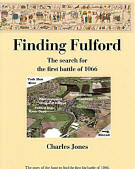All History Guide: Your guide to history on the Internet..
" .. this unusual, and yes, excellent history book.."
"More books like this one introducing historical study in a sympathetic was are needed.."
Now in paperback
... and into its 3rd reprint!
5. Potential of the site
5.1. This site has not been investigated by the developers or planning authorities to assess the economic, environmental or social potential of the site. The ODPM asks in D iv of his letter if it makes ‘best use of land, taking into account its density, layout, design, and level of car parking provision’. In the guidance issued for the historic environment the economic value of heritage is clearly set out:
“Conservation and economic prosperity
“1.4 Though choices sometimes have to be made, conservation and sustainable economic growth are complementary objectives and should not generally be seen as in opposition to one another. Most historic buildings can still be put to good economic use in, for example, commercial or residential occupation. They are a valuable material resource and can contribute to the prosperity of the economy, provided that they are properly maintained: the avoidable loss of fabric through neglect is a waste of economic as well as environmental resources. In return, economic prosperity can secure the continued vitality of conservation areas, and the continued use and maintenance of historic buildings, provided that there is a sufficiently realistic and imaginative approach to their alteration and change of use, to reflect the needs of a rapidly changing world.
“1.5 Conservation can itself play a key part in promoting economic prosperity by ensuring that an area offers attractive living and working conditions which will encourage inward investment - environmental quality is increasingly a key factor in many commercial decisions. The historic environment is of particular importance for tourism and leisure, and Government policy encourages the growth and development of tourism in response to the market so long as this is compatible with proper long-term conservation. Further advice on tourist aspects of conservation is given in PPG 21 and the English Tourist Board's publication Maintaining the Balance.”(PPG15)
- 5.1.1. The officers failed to make such an assessment. They failed to do this even though they were invited to do so in writing and in phone conversations. For a city where heritage plays such an important part in its prosperity, it is difficult to explain this calculated omission when the planning guidance makes it clear that an economic evaluation is a sensible exercise.
- 5.1.2. There is no formula to compare the benefit to the community that the extra visitors to a battlesite might bring, compared with the benefit of housing for the residents. The city needs both housing and heritage. It is a matter of judgment how much of each it needs. However, any judgment must be based on some information. It is the failure, indeed the refusal, to seek this information that is criticized here.
- 5.1.3. The mitigation for this omission would be to require that such an assessment was made before the application was determined.
5.2. Other battle sites attract substantial visitor numbers and Fulford is already served with car parking, public transport link and substantial public access.
- 5.2.1. If some effective presentation of Fulford was devised, the examples of Bosworth, Hastings and Culloden suggest that over 100,000 visitors will pay to enter a visitor centre per year.
- 5.2.2. The proximity of a ‘park & ride’ and a designer centre attracting several million visitors each year, and all this set in a city where visitors make a considerable contribution to the local income, it would seem obvious that the community should exploit the site as a unique international attraction. After all, nowhere else will ever be able to create another battle of Fulford site, especially one from the iconic year of 1066.
- 5.2.3. Scottish Heritage has recently invested several million pounds including removing modern features and trees from the battlefield of Culloden plus the re-direction of a road and a new visitor centre.
- 5.2.4. Abroad battle sites are generally better appreciated, including in the republic of Ireland and Northern Ireland. In the U.S.A. where the National Parks Authority cares for many battlefields, visitor numbers are measured in millions.
- 5.2.5. This battle has significance beyond the locality or even this island. Troops from Norway, Iceland and Flanders were victorious in this last great battle of the shield-walls in England. This makes the site an international visitor attraction that is worth adding to York’s portfolio.
- 5.2.6. With new legislation to protect England’s battlefields imminent, it would be wrong to allow it to be destroyed now. This would be a breach of the sprit of the law and an abuse of the legislative process. The economic value of the battlefield provides another rationale for rejecting the proposed access route.
5.3. The value of gifting planning permission to a single large house builder has been assessed without any alternative housing development models being investigated. The ODPM asks for the suitability of this assumption to be assessed. The way the site is developed is relevant to the conservation of the environment of the battle so some issues are explored here.
- 5.3.1. The model (25.1) is offered as an indication of the value transferred by the community to the landowner and developer. This invites a completely different development model to address the question raised by ODPM.
- 5.3.1.1. The weakness of leaving investigations to a party who has a vested interest in their outcome was noted earlier. The problem is exacerbated where there is neither civil nor criminal penalty associated with any misrepresentation.
- 5.3.1.2. If all of this investigative work was undertaken by the community, under the direction of the local planning department, only land that was approved would be released for a proscribed use. In this model, an agreement with the land-owner, similar to that entered into by the developer, and registered at the Land Registry would be a precondition for any investigation.
- 5.3.1.3. Once an area was investigated and approved by the planning authorities, it could be sold by auction or tender to house builders. This would not only fund the investigative work but yield a considerable revenue to the community if the figures modelled above apply. The model suggests that each dwelling yields £117,904 after building costs and the inflated cost of the land are deducted. This would pay for a lot of archaeology and, more seriously, return the premium to the community. (The Barker report suggest that planning permission increases the value of a piece of green-field land up to 300 times its agricultural value.)
- 5.3.1.4. The logic for this sequence of working is strongly implied by the targets set for planning approval by the OPDM in recent years. Without the prior investigations, any ‘zone-planning’ is of limited value. If the archaeology and environment of areas within a plan had been investigated by the community, the issues that are the subject of this particular inquiry would no longer be the responsibility of the developer. The suitability and technical merit of a site would have been sorted out within a democratically-accountable system before commercial interests became involved.
- 5.3.1.5. The benefit to the community would therefore be the income they would receive from the sale of planning permissions. For large, medium and small developers, much of the uncertainty would be removed. The planners would only have to deal with the developer to agree details of building and their layout. The strategic part of the planning process would be separated from the tactical decisions of disposition.
- 5.3.1.6. This sequence would put the community back in charge of the development in its area. With a powerful, financial incentive to release land, those who opposed any development would have to debate and decide what was right for the locality. The community, rather than developers, would therefore select the areas and set the parameters for each development.
- 5.3.1.7. It is unlikely that the ODPM had such a radical idea in mind but it does serve to illustrate how unaccountable a developer is to the community upon which they impose their plan. The figures provided show how unbalanced the rewards that flow from the granting of a planning application are which again favour the developer.
5.4. Not far from this proposed development is an area of the University now know as Halifax College. This area has grown organically to meet the needs of the university over the last 20 years. It now provides accommodation for over 1000 people, most in small houses. It covers approximately 4Ha, so it is a quarter of the size of the area that Germany Beck will devote to house building. Given that the national average of non-retired household occupation is 2.7, the same sort of mixed housing at the University could be accommodated in under half the area proposed. (750 houses x 2.7=2025 residents)
- 5.4.1. Given the plans presently being considered to expand the university, the model set by Halifax College would seem to be a much better one to follow. There is an obvious symbiosis between the two developments and it is an indictment of the planning process that it cannot direct that appropriate accommodation is built rather than the aspirational, commuter houses that feature in the plans submitted.
- 5.4.2. It is not clear if the ODPM intends to include the appropriateness of the type of housing within the scope of the inquiry but if that was the intention than the present plan should be rejected in favour of one that follows from the model developed by York University.
5.5. House-builders promote a model where availability is the key to affordability. Their argument goes that if the supply of housing is increased, the price will drop.
- 5.5.1. This was the view set out by the CBIs chief economist Kate Barker in the government sponsored report. However, there is evidence from academic studies to show that house prices respond to supply in a very much more complex way. In fairness to the Barker report, it spends more time analysing the way that windfall profits from development should be returned to the community but it is the suggestion that increasing supply will help lower prices that has been promoted by politicians and the building businesses.
- 5.5.2. Detailed study of regional house prices published by the Joseph Rowntree Foundation last year show that supply has a small effect on pricing. However the same model does explain why house builders favour certain types of house. House price differences, for example, exceed those in incomes because the 'income elasticity' for housing is about two. This means that a 10% change in income differential generates a 20% increase in the price people will pay for property. With the income differentials increasing, it is possible to sell bigger houses at even higher prices. House prices are driven by income just as much as supply.
5.6. There are other models for providing affordable houses being pioneered in the south where the young cannot afford to buy property because their employment will not permit the borrowing required. These are two radical but they are also so simple.
- 5.6.1. The first is pioneered by Community Land Trusts. This removes the ‘land inflation’ element from the house price. This has allowed schemes to sell homes at 30% below comparable alternative housing.
- 5.6.2. The second is embedded in the self-build movement where schemes report producing houses that are valued about 50% more than the costs. This apparently is being achieved by nothing more sophisticated than adopting sensible designs and of course, avoiding the land-price inflation that is normally taken by the developer.
5.7. There are clearly many big issues to be addressed in meeting the appropriate supply of housing to meet the needs of the community. Without more details from the developer, it is not possible to assess if they will meet these needs. The inquiry should therefore make any grant of permission to build conditional upon meeting parameters set by the community through its planning system and take account of the economic value of the battlesite.


